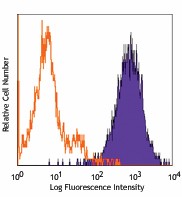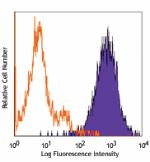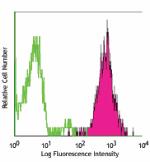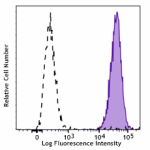- Clone
- FR70 (See other available formats)
- Regulatory Status
- RUO
- Other Names
- Ki-24, CD27-ligand, TNFSF7
- Isotype
- Rat IgG2b, κ
- Ave. Rating
- Submit a Review
- Product Citations
- publications

-

A20 cells stained with FR70 Biotin, followed by Sav-PE
| Cat # | Size | Price | Quantity Check Availability | Save | ||
|---|---|---|---|---|---|---|
| 104603 | 50 µg | 67€ | ||||
CD70 is a type II transmembrane protein. It is a member of the TNF superfamily, expressed on activated B cells, activated dendritic cells, and some activated T cells (low levels). CD70 interacts with CD27 to promote T-B cell cross-stimulation and co-stimulate B cell proliferation and immunoglobulin production. Cells expressing CD70 can co-stimulate T cell proliferation and enhance the production of cytokines. The FR70 antibody blocks CD70 binding to CD27.
Product DetailsProduct Details
- Verified Reactivity
- Mouse
- Antibody Type
- Monoclonal
- Host Species
- Rat
- Immunogen
- BALB/c mouse B lymphoma A20.2J
- Formulation
- Phosphate-buffered solution, pH 7.2, containing 0.09% sodium azide.
- Preparation
- The antibody was purified by affinity chromatography, and conjugated with biotin under optimal conditions.
- Concentration
- 0.5 mg/ml
- Storage & Handling
- The antibody solution should be stored undiluted between 2°C and 8°C. Do not freeze.
- Application
-
FC - Quality tested
- Recommended Usage
-
Each lot of this antibody is quality control tested by immunofluorescent staining with flow cytometric analysis. For flow cytometric staining, the suggested use of this reagent is ≤ 0.25 µg per 106 cells in 100 µl volume. It is recommended that the reagent be titrated for optimal performance for each application.
- Application Notes
-
Additional reported applications (for the relevant formats) include: immunoprecipitation1, in vitro blocking of CD70-CD27 binding and inhibition of T and NK cell responses1-3 , and immunohistochemistry4 of aceton-fixed frozen sections. For the most successful immunofluorescent staining results, it may be necessary to maximize signal over background by using a relatively bright fluorochrome-antibody conjugate (Cat. No. 104605/104606) or by using a high sensitivity, three-layer staining technique (e.g., including a biotinylated antibody (Cat. No. 104604) or biotinylated anti-rat IgG (Cat. No. 405402) second step, followed by SAv-PE (Cat. No. 405204)). To reduce non-specific binding to cells bearing Fc-receptors, pre-incubation of cells with anti-mouse CD16/CD32, clone 93 (Cat. No. 101301/101302), is recommended prior to immunofluorescent staining. The LEAF™ purified antibody (Endotoxin <0.1 EU/µg, Azide-Free, 0.2 µm filtered) is recommended for functional assays (Cat. No. 104608).
-
Application References
(PubMed link indicates BioLegend citation) -
- Oshima H, et al. 1998. Int. Immunol. 10:517. (Block IP)
- Akiba HH, et al. 1999. J. Immunol. 162:7058. (Block)
- Takeda K, et al. 2000. J. Immunol. 164:1741. (Block)
- Henke A, et al. 2000. J. Virol. 74:4284. (IHC)
- Brown SL, et al. 2007. J. Clin. Invest. 117:258.
- Product Citations
-
- RRID
-
AB_313116 (BioLegend Cat. No. 104603)
Antigen Details
- Structure
- TNF/NGF superfamily, 30-33 kD
- Distribution
-
Activated B cells and some activated T cells
- Function
- T-B cell cross-stimulation
- Ligand/Receptor
- CD27
- Cell Type
- B cells, T cells
- Biology Area
- Immunology, Costimulatory Molecules
- Molecular Family
- CD Molecules
- Antigen References
-
1. Barclay AN, et al. 1997. The Leukocyte Antigen FactsBook Academic Press.
2. Tesselaar K, et al. 1997. J. Immunol. 159:4959.
3. Akiba H, et al. 1999. J. Immunol. 162:7058. - Gene ID
- 21948 View all products for this Gene ID
- UniProt
- View information about CD70 on UniProt.org
Related FAQs
- How many biotin molecules are per antibody structure?
- We don't routinely measure the number of biotins with our antibody products but the number of biotin molecules range from 3-6 molecules per antibody.
Other Formats
View All CD70 Reagents Request Custom Conjugation| Description | Clone | Applications |
|---|---|---|
| Biotin anti-mouse CD70 | FR70 | FC |
| PE anti-mouse CD70 | FR70 | FC |
| PE/Cyanine7 anti-mouse CD70 | FR70 | FC |
| PerCP/Cyanine5.5 anti-mouse CD70 | FR70 | FC |
| APC anti-mouse CD70 | FR70 | FC |
Compare Data Across All Formats
This data display is provided for general comparisons between formats.
Your actual data may vary due to variations in samples, target cells, instruments and their settings, staining conditions, and other factors.
If you need assistance with selecting the best format contact our expert technical support team.
-
Biotin anti-mouse CD70

A20 cells stained with FR70 Biotin, followed by Sav-PE -
PE anti-mouse CD70

Mouse B cell line A20 stained with FR70 PE -
PE/Cyanine7 anti-mouse CD70

B cell lymphoma cell line, A20, was stained with True-Stain ... -
PerCP/Cyanine5.5 anti-mouse CD70

B cell lymphoma cell line, A20, was stained with CD70 (clone... -
APC anti-mouse CD70

B cell lymphoma cell line, A20, was stained with CD70 (clone...
 Login / Register
Login / Register 










Follow Us